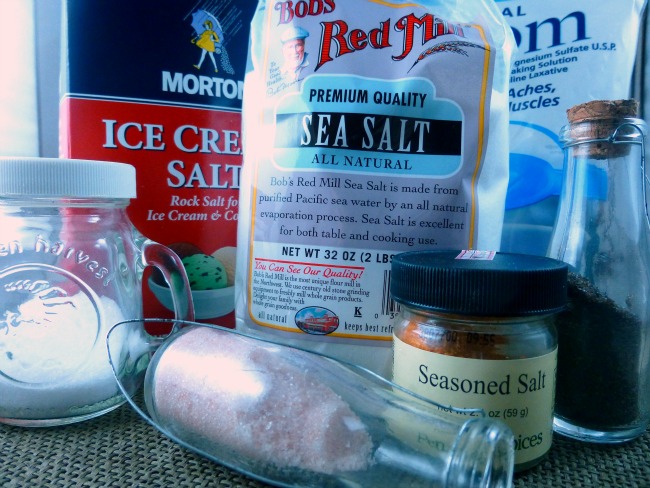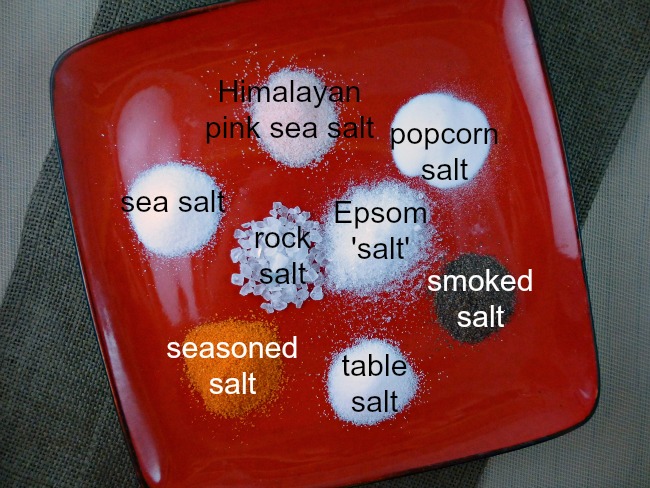by Arkansas Women Blogger member Mary Wood of Run of the Mill Mary
Growing up, we kept three types of salt in our house: iodized table salt, ice cream salt and Epsom salt. I never imagined all the salt possibilities available now. Here’s a basic guide to different kinds of salt and how to use them.

Table Salt: Mined from the earth by forcing water into a salt mine to create a mixture of salt and water. The water is then evaporated leaving salt. In the United States, iodine is added to most salt to prevent thyroid disease. This practice goes back to the turn of the century when much of the soil of the central northern states lacked iodine. Since most people only ate locally grown food, thyroid issues became a problem. Iodine was added to remedy this. Other ingredients are added to prevent caking. This is by far the most commonly used salt.
Canning or Pickling Salt: Used in home canning. Basic table salt without the added iodine or anti-caking agents, which can cause discoloration of canned foods.
Rock or Ice Cream Salt: Table salt before it has been refined and fine ground. Made up of large, gray-colored crystals. Salt lowers the freezing point of water. Rock salt capitalizes on this ability by helping to make ice cream, as well as de-icing roads and sidewalks.
Seasoned Salt: Table salt with added herbs and spices.
Popcorn Salt: Table salt ground fine to adhere to popcorn.
Sea Salt: Made by evaporating ocean or sea water. Contains trace minerals not found in salt from mines. There are many varieties that come from different seas and oceans around the world. Colors and mineral contents vary based on the source of the water. Different textures are created by varied methods of evaporation and harvesting. Sun, wind and low-heat boiling are some methods used for evaporation. More common types of sea salt include Himalayan Pink, Black salt, Hawaiian and French.
Smoked Salt: Salt that is smoked with any number of woods typically used for smoking foods. It adds a smoky taste that can be mild, bold, sweet or even infused with other flavors. It usually has a rich dark brown or gray color.
Kosher Salt: Kosher salt is not technically ‘kosher.’ It’s called kosher, because it was developed to help draw the blood out of kosher meats. Kosher salt is coarser and flakier than table salt. Because it’s not as dense, you should increase the amount if using in place of table salt. Check packaging for usage. A general rule is to use twice as much kosher salt as table salt. It’s usually not recommended for baking. Kosher salt crystals are too large for use in salt shakers but are perfect for adding a ‘pinch’ when cooking.
Epsom Salt: Epsom salt (magnesium sulfate) is not actually ‘salt’ (sodium chloride). It got is name from its discovery in Epsom, England and because it looks like salt. It’s used to ease sore muscles, remove splinters and as a laxative. Taking Epsom salt internally can cause serious life-threatening health effects, so consult a doctor before internal use.
Salt Substitutes: Uses potassium chloride and little or no sodium. Used primarily by those on salt-restricted diets for medical conditions.

Fun Facts about Salt:
- Salt is nutritionally essential for most plants and all animals, including humans.
- The word ‘salary’ comes from the word ‘salt.’ It was used as a form of currency in many cultures, and salt was a part of the compensation for Roman soldiers, thus part of their ‘salary.’
- The expression ‘not worth his salt’ comes from the practice of using salt to buy slaves in ancient Greece.
- Salt, symbolizing purity, is used in different religions around the world.
- Many wars throughout history have been fought over salt reserves.
- Salt is useful for seasoning, healing, preserving, manufacturing, de-icing and water conditioning.
- Of all the salt manufactured throughout the world, only 6 percent is actually used for food. The majority is used in industrial chemicals, water treatment and for de-icing roads.
- A pinch of salt can help you whip fluffier eggs and whipped cream.
- Add a potato to soup that is too salty. It will absorb some of the excess salt.
- Use salt to scrub clean a variety of things, including cutting boards. Rub it on the surfaces of frying pans and griddles to prevent food from sticking.
